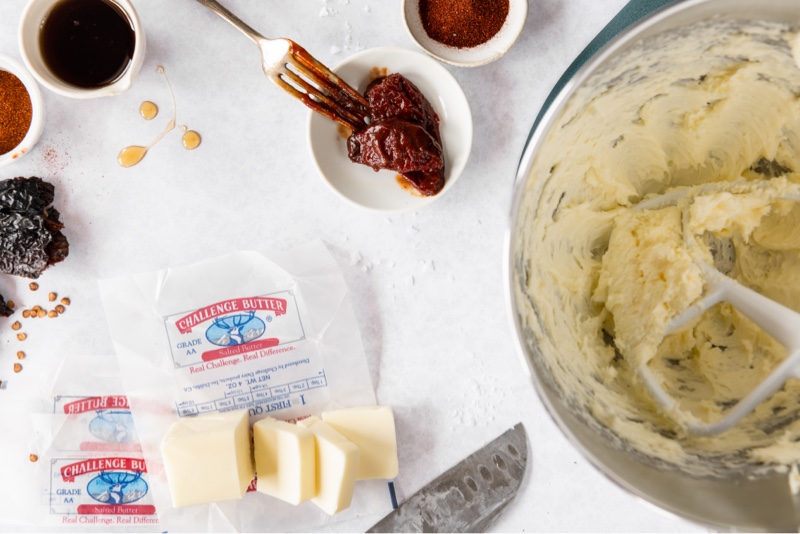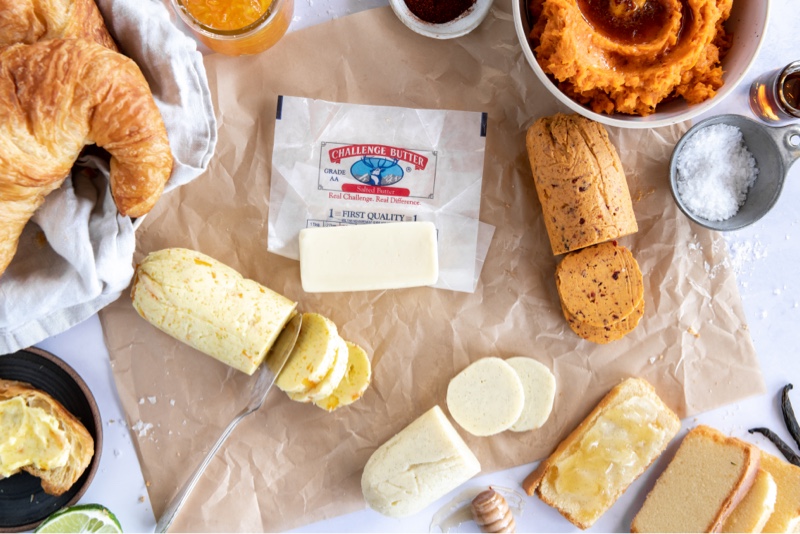Like accessories to an outfit, compound butter can make a dish. Whether on steak, seafood, pasta, cornbread, asparagus, popcorn, or just about anything, a pat of compound butter is often the bang-for-the-buck detail that makes a recipe work. Plus, making compound butter is practically effortless and requires no cooking. How many recipes can offer such benefits? Not many.
What exactly is compound butter? Just fold a handful of simple, complementary ingredients into a room-temperature stick of butter, form it into a log shape with plastic wrap, chill, and voila! You now have a secret weapon that will elevate any meal at short notice, with the slice of a knife.

Several of our best recipes make use of compound butter. There’s easy Chicken with Smoked Paprika Butter (a tasty riff on Hungarian paprikash), Cheeseburgers with Caramelized Onion Butter, and elegant Beef, Pork and Lamb Steaks with Bacon Chive Butter. Each uses the make-ahead magic of blending butter and mix-ins to bump the pizzazz factor on otherwise simple dishes.
Compound butter can complement more than just proteins or entrees. Melt Garlic Herb Butter in a cast iron pan for making an epic Grilled Cheese Sandwich. Set up a biscuit bar at your next gathering, with Citrus Butter, Maple Butter or Vanilla Bean Honey Butter. Stir Lemon Herb Butter into hot pasta or melt a pat of Chipotle Maple Butter on cornbread. Jazz up your pancakes and waffles with Brown Sugar Cinnamon Butter, or toss elote-style compound butter with hot popcorn for a play on Mexican street corn. The applications are practically endless.
But before you take compound butter to every meal (it’s tempting!), read our tutorial to master this flavor-boosting tool.
Use quality ingredients.
Of course it goes without saying that a dish is only as good as its ingredients, but in the case of compound butter, it’s especially true. When only a few ingredients combine, each one shines through. With Challenge, you always know you’re getting fresh butter made from real cream.
Bring your butter to room temperature.
Cold butter won’t blend with your mix-ins, and melted butter won’t keep its consistency to hold them in place. Room temperature is like Goldilocks and the Three Bears: not too cold and not too hot.
Blend a bit first.
Using an electric mixer or stand mixer to agitate the butter before folding in other ingredients helps ensure that they’re blended in evenly.
Gather fresh mix-ins.
Again, compound butters can’t skimp on quality or freshness. With just-snipped herbs, recently-ground spices, and other fresh ingredients, your final product will taste its best.
Limit your liquids.
Using liquids can make the consistency of compound butter too wet. If you’re folding in lime juice, tequila, or any other liquid, be sure to limit the measurement to 1 teaspoon per 1/2 cup of butter.
Incorporate ingredients thoroughly.
To reap the rewards of using compound butters, be sure to blend all ingredients thoroughly before using or storing. Otherwise, some sections may contain an abundance of mix-ins while others lack them.
Add salt at the end.
Adding salt at the end allows you to taste the butter on its own flavor. Once you’re happy with the mixture, start salting little by little to taste. After all, you can always add more salt, but you can never subtract it.
Use now, use later, or both.
If you plan to use your compound butter right away, incorporate it into a favorite dish in the kitchen, or transfer it to a crock or ramekin to serve at the table. Chill any leftovers as you would for a made-ahead log of compound butter. (See next tip.)
Make a log for future use.
If you’re making your compound butter to use later, spread the mixture onto an 8 to 10-inch square of plastic wrap or parchment paper. (If the butter seems a bit soft to handle, chill it for a few minutes.) Roll the butter inside the wrap, form it into a 1½-inch diameter log and wrap completely, crimping the ends.
Give it the chill.
Now let your butter chill, wrapped air-tight. If you use the refrigerator, use your butter within 2 to 3 days. If you freeze it, use it within several months.
Slice and serve.
Refrigerated butter is easy to slice into rounds, but frozen butter may need to thaw for 20 to 30 minutes.
Use at the beginning of a recipe, the middle, or the end.
The versatility of compound butter really can’t be overstated. Of course you can place a pat of Miso Garlic Butter on steamed vegetables at the dinner table, but you can also use it on the front end of a recipe. Try melting a round of Miso Garlic Butter in a skillet and saute a fish like Red Snapper in it for a couple minutes. Transfer to a 450 degree F oven for a few more minutes, remove the skillet, and flip the fish onto a plate. Drizzle with more melted Miso Garlic Butter and serve. Dinner is done!

